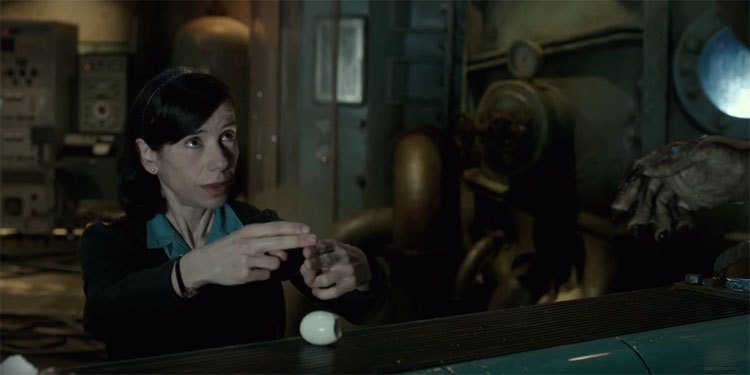Visual Medium, Visual Language: American Sign Language in Film

Its hard to imagine an audience who didn’t scream even once during a horror movie. Even at the tiniest jump scare, there is always one or two gasps and screeches as audience responses. However, there’s almost a public consciousness telling the viewers of A Quiet Place to not even make a sound. The antagonists of the film, who are massive spider-like creatures, can only attack when there is sound. In this film, silence is a way of protection. The family in the film needs to communicate with one another, and their knowledge of American Sign Language (ASL) allows them to communicate while surviving in this silent universe. Their knowledge of ASL protects them. Jon Krazinski’s film is not the only film that focuses on a character who uses sign language. Guilleirmo del Toro’s The Shape of Water focuses on a mute woman who makes a relationship with an amphibian-like man. With the successes of both of these films, one being the winner of the past Oscar’s best picture, does this show a public interest in nonverbal language in film?
The Creation of the “Talkies”: A Sound Revolution in Film
The first film with sound, or “talkie” as they were called, came out and surprised audiences with verbal speech in place of text screens. After the first talkie, The Jazz Singer, was released in 1927, audio was soon becoming the industry standard. Instead of simply seeing a character with music playing above their performance, they could now attach a voice to the characters. Despite The Jazz Singer’s use of offensive stereotyping at the expense of African American people (which has deteriorated its reputation today), it did help lead to what was called a “sound revolution” in the film industry. For years to come, films would all feature spoken word and written dialogue. However, with some small independent films here and there, representation of the Deaf community would be lowered at the cost of the advancement. Despite sound being viewed as a technological advancement in film, movies such as A Quite Place and The Shape of Water, become major financial and critical successes. The Shape of Water had 13 Oscar nominations, and had won the prestigious Best Picture Award, as well as three other awards at the 90th Oscar Award Ceremony. The film’s star, Sally Hawkins even was nominated for best actress. A Quiet Place made $50.2 million dollars at its box office debut. The only films of the year 2018 that have higher box office debuts are blockbusters from Marvel Studios, such as Black Panther and Avengers: Infinity War.
There was an influx of immigrants coming into the United States around the time of The Jazz Singer‘s release in 1927. American nationalism and ethnocentrism (or the belief that one’s country is superior to all others) lead to a massive language assimilation. This included public outcries for people speaking their native languages at the workplace. This included an outcry against American Sign Language being used publicly. It was not until the beginning of World War II, when there was a boom of employment of deaf men. Deaf men were entered into the draft at the time, so many were hired, alongside women, to have the jobs of the men drafted into the army. In Germany, deaf and mute citizens were prejudiced alongside Jewish citizens, leaving 1,600 deaf and mute individuals killed by Nazi soldiers. Henceforth, the time period in which del Toro chose for his film The Shape of Water, is significant to the treatment of the protagonist. Elisa is constantly scolded for her use of ASL, so she relates herself to other characters in the story who are mistreated, especially the amphibian man. She longs to free the creature, just as much as she longs to let her “voice” be heard and not feared.
“Deaf” vs. “deaf”
In today’s more culturally inclusive world, there are schools dedicated to helping students with deafness and muteness. There has also been an increase in public schools and universities having ASL classes. Now, the question is does the success of these two films show a newfound respect for nonverbal language? Will there be more films starring silent characters? It is fair to note that people who use ASL do not see their muteness and/or deafness as being a disability. According to the National Association of the Deaf, “deaf” refers to the physical condition of not being able to hear, while “Deaf” refers to a community of people who use ASL. To many of the individuals in this community, being “deaf” is not a disability, just another way of life. In the film A Quiet Place, the main reason why the family is still alive in their vacant dystopia is due to their use of ASL. They also come up with other ways to live their lives while avoiding making sound, such as using leaves instead of plates at dinner or placing sand over the leaf covered grass as they walk. The world of the previously mentioned “sound revolution” has fallen apart, its inhabitants all devoured. The lone survivors are the family of a Deaf child, and no one else.

Learning from the Community
To make the film as authentic as possible, Jon Krazinski, the film’s director, writer, and main actor, hired a Deaf child to play as his daughter. Krazinski stated in an interview that Millicent Simmonds, was one of the best actors he worked with. He also hired Douglas Ridloff, an ASL interpreter, to teach the rest of the cast members the language. Not only is the use of silence in language important to Krazinski and his film team, but also silence of any sound. There is only one scene where music is used, when the mother and father characters (played by Krazinski and wife, Emily Blunt, respectively) are listening to music through headphones. When filming, the crew strictly avoided making any sounds as to make diegetic synchronized sounds become more audible. Diegetic sounds are minuscule audio caused from actions such as stepping on leaves or rolling dice. The film makers go out of their way to engulf the audience into the world of silence, or in other words, to the world the characters are subjected.

Much like the characters in the story, ASL is not a choice, but a requirement of their daily lives. This mirrors the situation of people within the Deaf community, as they do not have a choice in the language they speak. Speaking in ASL for Deaf people is the only way they can express themselves and communicate. They do not have the luxury of verbalizing, but can only use writing to communicate in languages such as English. In The Shape of Water, Elisa is mute and is faced with discrimination based on her inability to speak verbally. This is why she forms a relationship with the sea creature. While the creature is contained in a small tank, Elisa feels suffocated by not being allowed to express her true feelings verbally. Both are feared by others for their differences, yet what makes them unique, makes them attractive.
Is there a Public Interest in Sign Language Today?
Both films show awareness and respect for the Deaf community and American Sign Language as a legitimate language. However, does this show a new respect and public interest into ASL in film? Only the following years will tell, if there is ever an increase in signing characters featured in popular movies. Yet, the film industry, and society as a whole, are increasingly inclusive. This can be viewed in the success of films such as A Quiet Place and The Shape of Water. Needless to say, silence is becoming another type of sound.
What do you think? Leave a comment.











I’ve wondered how many deaf people would rather have subtitles than signing. I also wonder how many deaf and and partially deaf people can understand BSL compared to being able to read English.
Impossible as it is to completely imagine being deaf, I find it difficult to believe that I would prefer to have a substantial portion of the image ruined rather than having subtitles which work perfectly well when I’m watching a foreign film.
In our increasingly digital age, it will indeed be possible to switch on and off the signers.
I am myself deaf since child, I dont follow their signing. Id rather have sub title. If deaf people read this are not happy what I have wrote that I am sorry but its true.
I brought up this matter on the BBC’s Point of View forum some time ago.
It would seem that many deaf people are not very good readers and are much happier when programmes are signed than when they are subtitled. It’s not a subject you can really get stuck into if you don’t want to be called nasty names and if you don’t have any facts (How many deaf people watch the signed programs? How many of them can read subtitles well enough to make that a viable alternative?) and. I came away feeling that a lot of people would feel hard done by if the BBC did away with signing. I don’t recall if the red button came up and if it did why its use wasn’t considered acceptable
The BBC finds itself in a tight spot, funding a public service from contested licence fees. I too am in a kind of tight spot in such debates because I’m an expat and so I don’t pay any licence fee at all, though I do pay one for the French television service that I’ve totally stopped watching so bad is it. At least British people living in Britain can watch some stuff on iPlayer, so missing a programme is not as bad for you as it was, though I don’t suppose it allows you to watch any films. Tough!
I think that the format in which films are broadcast is a much worthier practice to target. It would be nice if the BBC could broadcast in the original format, or at least in as close to the original format as possible so that we don’t have these preposterous situations where the 2 off screen people are heard exchanging words! Meanwhile I think that deaf people would say ne tirez pas sur le signeur…
Shape of water is a good movie, not a great one in my opinion. Super performances from all involved, looked beautiful but ultimately left me underwhelmed.
It was a thoroughly enjoyable movie and a wonderful vehicle for Sally Hawkins who was better than perfect.
I have a real soft spot for b-movie style monsters and outcasts, especially the misunderstood ones with noble hearts.
I really enjoyed it. Lovely film.
I loved it. Typically Del Toro, the influences of his cinematic heroes are everywhere, both obvious and subtle.
I thought it was quite beautiful to look at (almost distractingly so), but a mediocre film otherwise.
Enjoyed A Quiet Place, but wondered how the family managed to generate electricity on such a massive scale and, given that they could do so, why did they have a petrol burning lamp, which at one point causes a fire? The industrial level of corn production was rather difficult to believe too. I suppose you could just about manage to plant and harvest corn in silence, but not several acres worth. Anyway, it had me gripped.
Also getting swallowed by corn but five minutes later being OK and not drowning in corn. Meh. Dumb AF
There is no doubt that sign language is part of the linguistic repertoire of humans. From what I have read, it seems that there are maturation effects so that late learners of the language sign with an “accent”, in the same way that late learners of spoken language may continue sounding like a second language speaker. This, and a lot else, shows that SL is just one more language. When I see signers communicating, I feel envious of their skill, and wonder what it would be like to use that language.
From my own experiences, speaking sign language is like speaking another language, like French, once you get used to it. You find yourself thinking in signs and how you’re going to sign what you want to say.
It’s a nice language to communicate in. For a lot of deaf people at my school and myself, it’s clearer and easier to use. Some of the signs are very pretty and feel great to use. Like the sign for “autumn” (my favourite sign) is a particular one that I find to be pretty. I do find myself envying my classmates who can sign a lot more than me for their skills and awed at the same time.
I’ve never heard about that with the accents. That’s very interesting to read. I also know British Sign Language has regional accents just like any other language. Like the sign for the colour “yellow” differs in regions of England and the accent can be recognised too.
Culbertson. It’s never too late to learn something new. I’m in my late 50s and my mother is rapidly losing her hearing. As well as creating subtitles to accompany her favourite films, I’ve also started to learn sign language (BSL) with her, so that she and I will always be able to communicate – even if some personal eccentricities have started to creep into our ‘signing’. I’d say to you ‘Give it a go’. It’s fascinating…and it keeps those fingers nimble 🙂
Very interesting read. In terms of language learning and communication frameworks, I find this fascinating.
I really enjoyed watching Michael Shannon being violent. I’d like to see more of that.
What do you mean? He gets violent all the time. His face is in a default violent mode 24/7.
I thought Quiet Place was an excellent film, really enjoyed the concept of how they had to stay alive, and how that transpired to living their lives.
The film built suspense masterfully and didn’t allow the viewer much time to catch their breath.
Moving, intelligent and scary.
I absolutely loved this. It was by far the most tense movie I have seen in quite a long time. Was quite surprised by how quiet the cinema audience were during the screening I was at and the only noise was coming from me coughing. Oops. Such a clever, interesting movie. So glad its doing well with a slight caveat. Please Hollywood, just because its successful, it doesn’t mean it needs a follow up be it a sequel, prequel or a spin off. Leave it
I thought it was terrific; a simple concept – brilliantly executed. And the family at the centre of it were brilliantly written and acted; you really root for them – unlike most horror films that revolve around a bunch of gormless, annoying, sexy airheads. In fact the story at the heart of the film is really one about a family struggling to come to terms with a past tragedy, which the gives the film real depth and heart.
Of course, the film requires the audience to suspend disbelief quite significantly and just ‘go with it’, and if you’re not willing or able to do so, you’ll probably think it’s a load of old nonsense.
This was a flat-out horror masterpiece.
Thanks for your article, Kellie. ‘The Shape of Water’ sounds intriguing. I’ll give it a go.
John Krazinski made a concerted effort to cast a deaf actress in A Quiet Place. I wish Guerillmo Del Toro had done the same in The Shape of Water. If given the chance a deaf actor can be just as good (if not more formidable) as a hearing actor. For example, Marlee Matlin was brilliant in Children of a Lesser God, and it wasn’t because she was playing a deaf character. She was profound in that role because of the way she communicated the text and subtext to form her narrative. Unfortunately, she worked little after her Oscar winning role as Sarah in COALG. Deaf or disabled actors are truly the Rodney Dangerfield of actors when comes to the selective and skewed about of respect they receive when it comes to casting. While some behind the camera (Krazinski) have reconciled their ethos as actors, others in Hollywood (Del Toro) continue to ostracize their talent in short strokes.
Nice article, heartily suggest you read Oliver Sacks’ book. Seeing Voices.
First of all, wonderful article! It’s very well written and insightful. Also, as someone who is hard of hearing, I thoroughly enjoyed seeing the representation in “A Quiet Place”, and to know that Krasinski and his crew worked so hard to keep the movie set inclusive for Millicent just warms my heart. I really hope this is the future for film, and for great storytelling overall.
Great article! Definitely a topic I haven’t seen/read much of in relation to the movie industry. On an anecdotal level, I’ve noticed a trend towards more inclusivity for HoH folks online–subtitles are pretty much available on all major social media platforms for videos of all kinds. I wonder if this translates to an uptick in popularity for ASL classes in public schools and universities?
A lovely read, keep up the great work!
I haven’t gotten a chance to see The Shape of Water but did get to see A Quiet Place. I thoroughly enjoyed A Quiet Place and how ASL played such a huge role to the movie. Wonderful article and good job addressing important topics regarding ASL and the Deaf community!
I really appreciated this discussion, thank you.
Really good article. This is a topic that is rarely talked about, and it is about time more films are created depicting people with special circumstances.
A few key points:
1. It would be helpful to add a reference explaining there was an outcry against American Sign Language
2. Adding names of ASL support groups/helpful incidents would be great, because there should definitely be more support for ASL and other unique groups.
“another type of sound”…. beautiful
Imagine a movie, completely done in sign language. It would be amazing if it became the new norm or a new genre. It would really rely on directors to show more than say more. Hitchcock might be a good one to look at. He adds dialogue last because he tries to explain everything through image.
(That awkward moment when a lot of people discuss their opinions on the films, rather than on the use of ASL). One thing I believe would be challenging about including sign language is regionalization; much like in spoken English, certain signs are different based on where someone lives. But if it is signed and not written, there is no way of looking up what the word might be. That aside, that’s not to say anything negative toward inclusion. I personally (as a former ASL student) would like to see more signing and Deaf/deaf people in films. I honestly feel as if everyone should learn ASL as a standard.
Here’s an interesting example of a deaf character from the era of Film Noir!
I’m currently in a Film Genres course at my college and we just watched Out Of The Past, which features a deaf character named “The Kid.” It’s problematic because other characters refer to him as “dumb,” but he’s actually a key player in the movement of the plot. If I’m remembering correctly, he doesn’t use ASL, but he reads lips and uses general gestures. The Kid is arguably more intelligent and empathetic than the hard-boiled main characters, and it’s implied that this is because he spends a lot of time observing how these double-crossing people behave. In the end, he tells a lie to the main characters’ former fiancee to save her from feelings of unrequited love for the rest of her life– essentially, he chooses to tell a little white lie to maintain her ignorant bliss. I really liked the character of The Kid.